Is Your Metal Roof Truly Wind Resistant?

By Rob Haddock, CEO and Founder of S-5!.
Today, ASCE 7-16 – criteria for determining wind loads – is increasingly incorporated as states update building codes.
Did you know the bar is changing within the standards that govern wind design? Although most states are still using minimum design standards set forth by the American Society of Civil Engineers in ASCE 7-10 (2010 edition), the standard was revised several years ago. Today, ASCE 7-16 – criteria for determining wind loads – is increasingly incorporated as states update building codes. This also means wind maps have changed in certain parts of the country. These changes, along with others, have resulted in increased design requirements in most cases.
Certainly, new construction will need to adhere to newly adopted standards, but now an existing roof appropriately designed to meet codes a mere two decades ago might fall short of expected performance in a windstorm today.
What affects wind forces?
Both the overall terrain and the building’s immediate surroundings impact wind speeds. Valleys, hills, slopes and cliff-sides in addition to obstacles in the wind’s path, such as nearby buildings and wooded areas can reduce – or in a few cases – increase ground wind speeds. The absence of obstacles and wide-open terrain or open-water surfaces can set the stage for increased wind speeds.
Generally speaking, high wind-prone areas are found in coastal communities (like Florida) and in some mountainous regions, while most interior states are considered lower wind-prone areas.
Because wind speeds vary throughout the country based on topography and geography, the minimum standards for design wind forces vary according to these regions. Among other factors, the design wind speed is determined by the area’s highest recorded three-second wind gust (measured 33’ above ground). The size, geometry and architecture of the building alter the wind forces acting upon it. For example, a 60-foot-tall building will experience stronger wind forces than a 30-foot-tall building, even if both buildings are in the same area with the same design wind speed.
When ground-level wind flow meets a building’s wind-facing façade, it is diverted upward and over the structure, flowing above the roof. As it does, it gains velocity. Where it breaks over the eave or gable, it generates negative pressure (suction) directly above those roof surfaces. This is also called “uplift” force, or “wind uplift pressure.” It is the same principal of how airflow over an airplane wing lifts the plane.
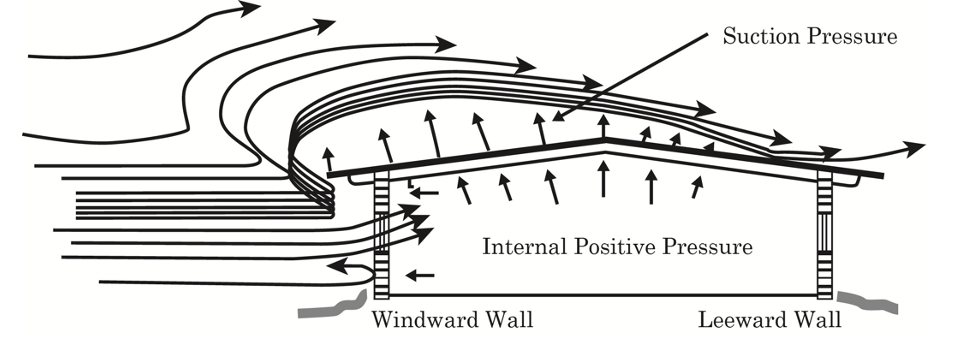
The objective of any design engineer is to convert the actual wind speed experienced at (33’ above) the ground into units that he can design via pounds per square foot (psf) on the roof. When it comes to quantifying uplift pressures on these different roof “zones” (in psf), an engineer takes into account the design wind speeds (mph) along with building geometry and surrounds. This information is converted to uplift pressures (psf) in accordance with the rules and “importance factors” dictated by the building occupancy (i.e., hospital vs. cowshed) – as established by ASCE-7 and/or local code authorities.
The “allowable” wind resistance of any roof assembly (in psf) can be enhanced by methods and frequency of its attachment to the structure and in other ways as well. It must be proven and quantified by industry-accepted test standards and protocols.
Standing seam metal roofing is your best bet to withstand wind uplift forces
Among the different types of metal roofing, standing seam roofing (SSR) is considered among the most wind-resistive roofing options because the panels interlock at their seams, serving as a “structural” covering. In fact, SSR can be engineered to withstand even Category 4 and 5 hurricane wind forces. The roof covering and building structure, together, represent the complete assembly. Therefore, the overall resistance to wind relies on the strength of the following components and connections:
- The strength of the seam itself;
- The strength of the clip’s attachment to the seam;
- The strength of the clip itself;
- The clip’s attachment to the roof deck or structure (the clip screws); and finally,
- The limitations of the structure itself.
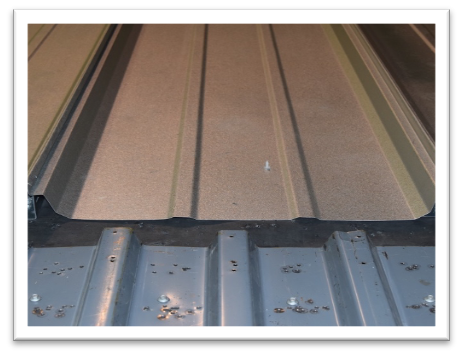
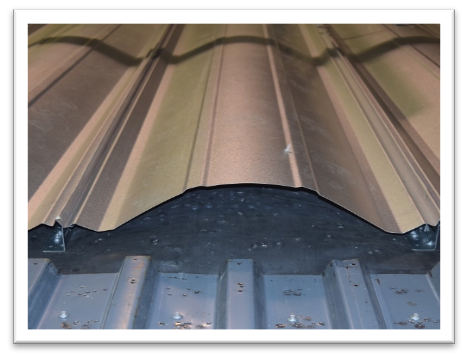
These components comprise a “load chain,” which is only as strong as its weakest link. Because of its complexity, most often a load-chain’s strength is determined by full-scale assembly testing.
Proven ways to fortify your roof
As with all best laid plans, load-chain failures may still occur – on SSR most commonly clip disengagement and seam separation. Clip disengagement happens when wind suction causes the panel seam to distort, allowing it to disengage from the mounting clip. Seam separation occurs when the suction pressure on the panel pulls the seam sideways causing it to unwind, which separates the male and female edges from each other. Other links may fail too – clips can break or fasteners pull out.
But, engineering and testing has proven several ways to improve wind resistance!
In new construction, you can:
- Increase the metal’s gauge thickness,
- Decrease the panel width, or
- Increase the fastening along the seam.
For both new construction and existing buildings, you can:
- Do any (or all) of the above, or
- Use external seam clamps.
External seam clamps offer cost savings and improved wind resistance
So, what is an external seam clam (ESC)? They are small clamps placed over the roof’s seams at designated intervals to increase the roof’s wind resistance capacity, preventing multiple modes of failure, including seam separation and clip disengagement when used at roof clip locations.
Consider your options through a cost-benefit-analysis lens for your roof, and you’ll find ESCs generally offer by far the greatest measure of improvement for the lowest cost. However, while these clamps are a great solution to guard against wind uplift, “generic” ESCs are ill-advised. Anyone can make a clamp and call it an “ESC.” That doesn’t make it effective.
It’s critical to utilize a seam clamp designed for the specific purpose and specific panel profile, and proven quantitatively to achieve a reasonable level of assurance that it will do what it is supposed to do. Otherwise, you won’t be able to calculate the strength (and resulting roof integrity) you’re seeking. S-5! has developed highly tested WindClamps™ since 1995 as a proven method for SSR reinforcement.
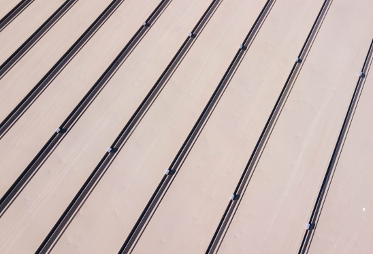
Here are some benefits to using them:
- You can increase allowable loads by as much as 300% without costly structural modifications, which helps meet new ASCE 07-16 requirements;
- In cases where a SSR standard construction does not meet design test pressures, the addition of eternal seam clamps may make using this roof type viable;
- ESCs can easily be added to a metal roof specification in new construction; and
- ESCs can be easily used to bring existing buildings into compliance with current codes and wind standards – for pennies per square foot.
Combined with our in-depth knowledge of how the total roof assembly responds to wind uplift, WindClamps™ can help you meet ASCE 7 -16 standards and, most importantly, protect your roof, property and building occupants.
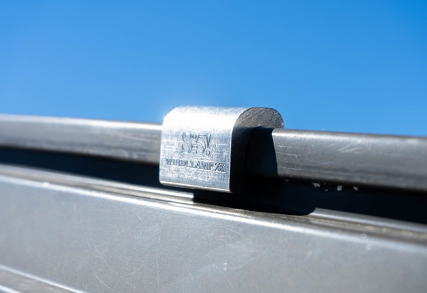
Learn more about S-5! WindClamps.
Learn more about S-5! in their RoofersCoffeeShop® Directory or visit s-5.com.














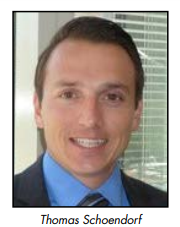
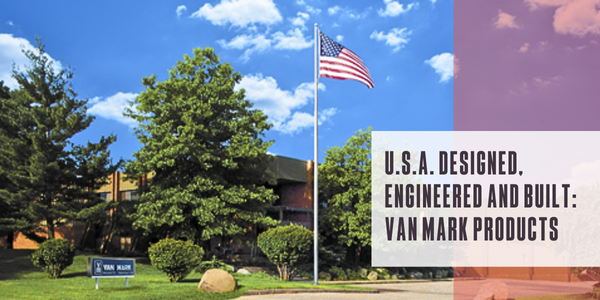







Comments
Leave a Reply
Have an account? Login to leave a comment!
Sign In